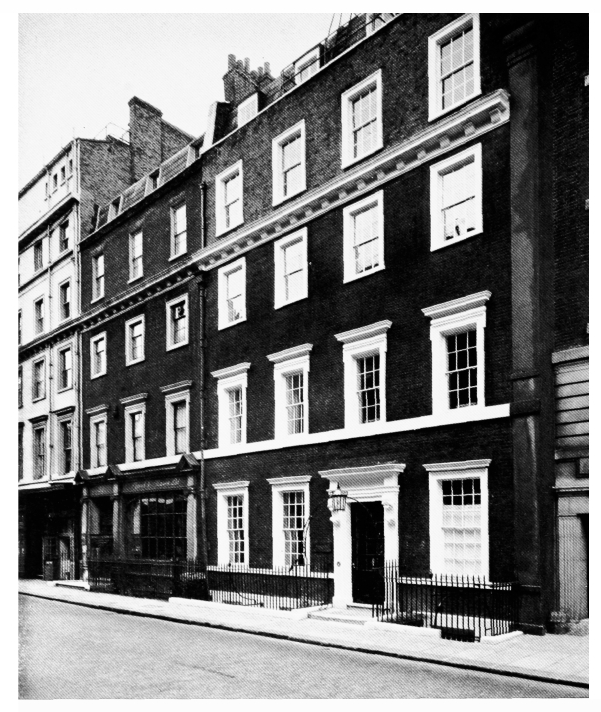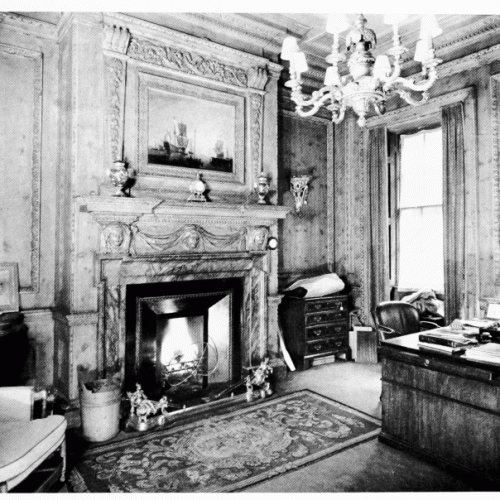History of 31 Old Burlington Street
History of 31 Old Burlington Street
Once part of the Burlington Estate, 31 Old Burlington Street was built in 1718 and designed by architect Colin Campbell for Lord Burlington. This is a is a Grade I Listed early Georgian Town House of the First Class with six storeys, including the ground floor and one basement level. It features an innovative terrace design with four wide windows. The entrance is located in the second bay from the right, and comprises of a door with six fielded panels including a rectangular fanlight in a stone door case with carved consoles and cornice. The impressive interior is fully panelled with decorative carving and mouldings concentrated in the ground floor reception rooms. The plain wall is intended for fresco, the existing painting being of a suitable Kent location of the early 20th century; and including enriched mouldings and carving to fine deal panelling and fully developed chimney pieces with enriched pilaster frames to over mantels. The principal main 18th Century oak staircase serving the ground and first floor is hand carved and decorated to the highest of standards with enriched mouldings and carvings. First floor rooms have a simplified version of same scheme, in keeping with further decoration of the early 20th century.
The original house is one of a terrace of four, numbered 29-32, of which only numbers 31 and 32 have survived.
There were several families occupied the house from 18th through 20th century. They were:
Sir William Stapleton, 4th Baronet
The house was first occupied in 1724 by the lessee, Sir William Stapleton (1698-1740), baronet, who in April of that year mortgaged it to secure £2000, to the mason, Edward Strong, junior (who was associated in his trade with two other masons associated with the history of Burlington House and estate, Christopher Cass and Edward Tufnell). Strong was a subscriber to Campbell’s, Leoni’s and Gibbs’s books of architecture, and may have been associated with the building of the house. In the following year, however, Sir William assigned his lease to John, Lord Hervey for £3600.
Sir William Stapleton sat as MP for Oxfordshire 1727-1740.
John, Lord Hervey
John, Lord Hervey lived in the house from October 1725 till 1730. John Hervey, 2nd Baron Hervey PC (13 October 1696 – 5 August 1743), English courtier and political writer and memoirist, was the eldest son of John Hervey, 1st Earl of Bristol, and his second wife, Elizabeth. He was known as Lord Hervey from 1723. However, Lord Hervey did not become Earl of Bristol, as he predeceased his father.
In November 1730, Hervey assigned his lease to his great friend Stephen Fox (1704–1776), later first Earl of Ilchester.
First Earl of Ilchester Stephen Fox-Strangways and His Family
In 1732 Stephen Fox bought the freehold from the Pollen family and lived here until 1776. Upon entering the house it is evident that Fox had embellished this, perhaps with the fine wainscoting still existing on the ground floor. In December 1731 Lord Hervey wrote to Fox, who was then out of London, telling him that he had called on his friend Richard Arundell at No. 34, ‘and being so near your house called in to see it. It is quite finished, and looks the smuggest, sprucest, cheerfulest thing I ever saw. Nothing can improve it but a piece of moveable goods of my acquaintance, which I expect home with more impatience than I can tell you.’
The Ilchester family remained here until the 1860’s together with the following descendants.
- Henry Thomas Fox-Strangways, 2nd Earl of Ilchester (1747–1802), the eldest son of Stephen Fox-Strangways, known as Lord Stavoradale from 1756 to 1776. He was a British peer and Member of Parliament
- Henry Stephen Fox-Strangways, 3rd Earl of Ilchester (1787–1858), the eldest son of 2nd Earl, British peer and Whig politician. He served as Captain of the Yeomen of the Guard under Lord Melbourne from 1835 to 1841.
- William Thomas Horner Fox-Strangways, 4th Earl of Ilchester (1795–1865). He was a British diplomat, Whig politician and art collector.[1] He served as Under-Secretary of State for Foreign Affairs under Lord Melbourne from 1835 to 1840 and was Envoy Extraordinary and Minister Plenipotentiary to the German Confederation from 1840 to 1849.
- Henry Edward Fox-Strangways, 5th Earl of Ilchester (1847–1905). He succeeded his uncle in the earldom of IIchester in 1865. He was a British peer and Liberal politician. He served as Captain of the Honourable Corps of Gentelmen-at-Arms under William Ewart Gladstone between Januarary and February 1874.
Second Viscount and Lady Lismore
The house was occupied by the second Viscount George O’Callaghan (1815-1898) and Lady Lismore. Second Viscount served as an Officer in the service of the 17th Lancers. He held the office of High Sheriff of County Tipperary in 1853. He succeeded his father on 30 May 1857, becoming 2nd Viscount Lismore of Shanbally in the County of Tipperary.
Messrs. Lenygon
Lenygon and Morant, a British decorating company holding royal warrants under four successive British kings, used this house as a showroom for antique furnishings. The company combined the use of antiques, reproductions and architectural salvage in British and American interiors during the first half of the 20th century. Founder Francis Lenygon (1877-1943) promoted the taste for period style through publications on English antiques; the most well-known becoming standard texts for the history of English furnishings, as well as decorators’ manuals. The company bought cabinetmaking firm Howard & Sons (1820-1934) in 1934. In 1935 Howard and Sons traded from 31 Old Burlington St where they produced mainly upholstered furniture. They ceased trading in 1947 and then advertised as ‘Makers of Howard Chairs and Sofas’ by Lenygon and Morant when the company later moved to 48 South Audley St in 1954.
Present
In 1958, 31 Old Burlington Street was occupied by Textiles showroom offices. Thereafter the house was occupied by offices from the 1970s until 2015.










